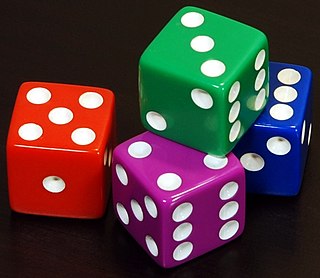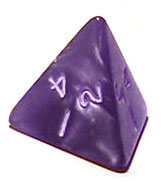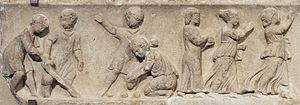
Board games are tabletop games that typically use pieces. These pieces are moved or placed on a pre-marked board and often include elements of table, card, role-playing, and miniatures games as well.

Dice are small, throwable objects with marked sides that can rest in multiple positions. They are used for generating random values, commonly as part of tabletop games, including dice games, board games, role-playing games, and games of chance.

Senet or senat is a board game from ancient Egypt that consists of ten or more pawns on a 30-square playing board. The earliest representation of senet is dated to c. 2620 BCE from the Mastaba of Hesy-Re, while similar boards and hieroglyphic signs are found even earlier, including in the Levant in the Early Bronze Age II period. Even though the game has a 2,000-year history in Egypt, there appears to be very little variation in terms of key components. This can be determined by studying the various senet boards that have been found by archaeologists, as well as depictions of senet being played throughout Egyptian history on places like tomb walls and papyrus scrolls. However, the game fell out of use following the Roman period, and its original rules are the subject of conjecture.

A toy or plaything is an object that is used primarily to provide entertainment. Simple examples include toy blocks, board games, and dolls. Toys are often designed for use by children, although many are designed specifically for adults and pets. Toys can provide utilitarian benefits, including physical exercise, cultural awareness, or academic education. Additionally, utilitarian objects, especially those which are no longer needed for their original purpose, can be used as toys. Examples include children building a fort with empty cereal boxes and tissue paper spools, or a toddler playing with a broken TV remote control. The term "toy" can also be used to refer to utilitarian objects purchased for enjoyment rather than need, or for expensive necessities for which a large fraction of the cost represents its ability to provide enjoyment to the owner, such as luxury cars, high-end motorcycles, gaming computers, and flagship smartphones.

Saturnalia is an ancient Roman festival and holiday in honour of the god Saturn, held on 17 December of the Julian calendar and later expanded with festivities through 19 December. By the 1st century B.C., the celebration had been extended through 23 December, for a total of seven days of festivities. The holiday was celebrated with a sacrifice at the Temple of Saturn, in the Roman Forum, and a public banquet, followed by private gift-giving, continual partying, and a carnival atmosphere that overturned Roman social norms: gambling was permitted, and masters provided table service for their slaves as it was seen as a time of liberty for both slaves and freedmen alike. A common custom was the election of a "King of the Saturnalia", who gave orders to people, which were followed and presided over the merrymaking. The gifts exchanged were usually gag gifts or small figurines made of wax or pottery known as sigillaria. The poet Catullus called it "the best of days".

A doll is a model typically of a human or humanoid character, often used as a toy for children. Dolls have also been used in traditional religious rituals throughout the world. Traditional dolls made of materials such as clay and wood are found in the Americas, Asia, Africa and Europe. The earliest documented dolls go back to the ancient civilizations of Egypt, Greece, and Rome. They have been made as crude, rudimentary playthings as well as elaborate art. Modern doll manufacturing has its roots in Germany, from the 15th century. With industrialization and new materials such as porcelain and plastic, dolls were increasingly mass-produced. During the 20th century, dolls became increasingly popular as collectibles.

A spinning top, or simply a top, is a toy with a squat body and a sharp point at the bottom, designed to be spun on its vertical axis, balancing on the tip due to the gyroscopic effect.

Four-sided dice, abbreviated d4, are often used in tabletop role-playing games to obtain random integers in the range 1–4. Three forms exist of this die: a tetrahedron with four equilateral triangle-shaped faces, a rectangular prism with rounded or pointed ends, and an elongated long die with four triangular faces. The latter type does not roll well and is thus usually thrown into the air or shaken in a box.

The Royal Game of Ur is a two-player strategy race board game of the tables family that was first played in ancient Mesopotamia during the early third millennium BC. The game was popular across the Middle East among people of all social strata, and boards for playing it have been found at locations as far away from Mesopotamia as Crete and Sri Lanka. One board, held by the British Museum, is dated to c. 2600 – c. 2400 BC, making it one of the oldest game boards in the world.

The Basilica Julia was a structure that once stood in the Roman Forum. It was a large, ornate, public building used for meetings and other official business during the Roman Empire. Its ruins have been excavated. What is left from its classical period are mostly foundations, floors, a small back corner wall with a few arches that are part of both the original building and later imperial reconstructions and a single column from its first building phase.

Hoop rolling, also called hoop trundling, is both a sport and a child's game in which a large hoop is rolled along the ground, generally by means of an object wielded by the player. The aim of the game is to keep the hoop upright for long periods of time, or to do various tricks.

A game is a structured type of play, usually undertaken for entertainment or fun, and sometimes used as an educational tool. Many games are also considered to be work or art.

The history of games dates to the ancient human past. Games are an integral part of all cultures and are one of the oldest forms of human social interaction. Games are formalized expressions of play which allow people to go beyond immediate imagination and direct physical activity. Common features of games include uncertainty of outcome, agreed upon rules, competition, separate place and time, elements of fiction, elements of chance, prescribed goals and personal enjoyment.

Girls' toys and games are toys and games specifically targeted at girls by the toy industry. They may be traditionally associated either exclusively or primarily with girls by adults and used by girls as an expression of identity. One commentator have argued that the market for girl's toys and games is more challenging than that for boys' toys and games.

The Gambler's lament is one of the hymns of the Rigveda which do not have any direct cultic or religious context. It is found in the late Tenth Book, where most of such hymns on "miscellaneous" topics are found, suggesting a date of compilation corresponding to the early Indian Iron Age. The hymn was composed by either Kanvasha Ailusha or Aksha Maujavant.

Hoo Hey How is a Chinese dice game played with three identical six-sided dice. It is related to Bầu cua cá cọp in Vietnam, Klah Klok in Cambodia, and similar to Crown and Anchor in the West Indies and the American game chuck-a-luck.

De arte aleae is the name of a now-lost book written by the fourth Roman emperor Claudius. As the name suggests, it details how to play the game of dice.

Crepereia Tryphaena was a young Roman woman, presumably about 20 years old, whose sarcophagus was found during the excavation works started in 1889 for the foundations of the Palace of Justice and for the construction of the Umberto I bridge over the Tiber in Rome. Among the items found in her sarcophagus were pieces of a funeral outfit, including a sculpted doll.

Early Native American recreational activities consisted of diverse sporting events, card games, and other innovative forms of entertainment. Most of these games and sporting events were recorded by observations from the early 1700s. Common athletic contests held by early American tribes included games of stickball, chunkey, archery, darts, foot races, and canoeing. Card and dice games were commonly used as forms of entertainment among tribes such as the Iroquois and Lakota. Several contests and games invented by American indigenous groups contributed to modern-day sports and casino play. Several indigenous games were tribe-specific; one of the most common games played specifically by the Iroquoian was the Bowl Game, played using colored balls and sticks.
Five Lines is the modern name of an ancient Greek tables game. Two players each move five counters on a board with five lines, with moves likely determined by the roll of a die. The winner may have been the first one to place their pieces on the central "sacred line". No complete description of the game exists, but there have been several scholarly reconstructions, including Schädler's and Kidd's.


























